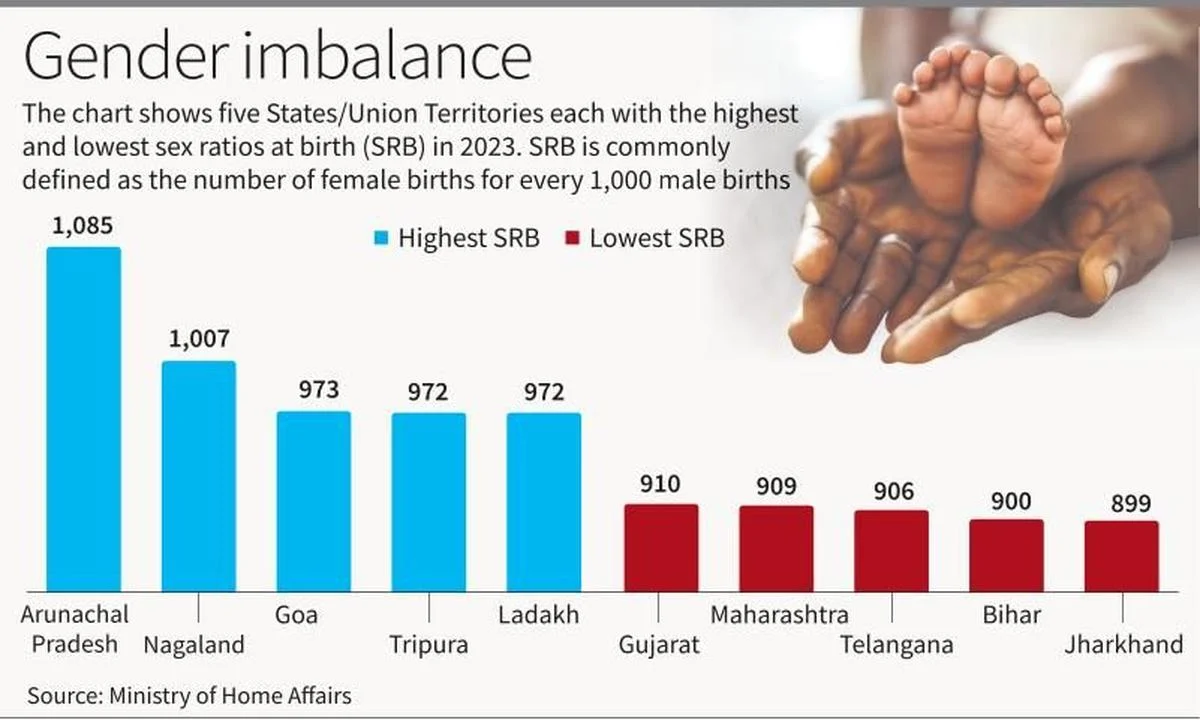Facts for UPSC Mains
India’s Vital Statistics Report 2023
- 15 Oct 2025
- 8 min read
Why in the News?
The Registrar General of India (RGI) released the “Vital Statistics of India based on Civil Registration System (CRS)” report for 2023. The report highlighted a decline in birth registrations and a marginal increase in death registrations.
What are the Key Findings of the Vital Statistics Report 2023?
- Birth and Death Trends; India registered 2.52 crore births in 2023, about 2.32 lakh fewer than in 2022, indicating a slight decline in the overall birth rate.
- The number of registered deaths stood at 86.6 lakh in 2023, a minor increase from 86.5 lakh in 2022.
- There had been a sharp spike in 2021, with 1.02 crore deaths - an excess of nearly 21 lakh deaths from 2020, coinciding with the second wave of COVID-19.
- Sex Ratio at Birth (SRB): SRB refers to the number of female births per 1,000 male births.
- Lowest SRB: Reported in Jharkhand (899), followed by Bihar (900), Telangana (906), Maharashtra (909), Gujarat (910), Haryana (911), and Mizoram (911).
- Highest SRB: Arunachal Pradesh led with a sex ratio of 1,085 females per 1,000 males, followed by Nagaland (1,007), Goa (973), Ladakh and Tripura (972 each), and Kerala (967).
- Institutional Births: About 74.7% of total registered births in 2023 occurred in health institutions, reflecting gradual improvement in maternal and neonatal healthcare access. Overall registration of births for the year 2023 stood at 98.4%
- Timely registration refers to births registered within 21 days of occurrence.
What are the Reasons for the Skewed Sex Ratio in India?
- Gender Bias: A deep-rooted cultural preference for male heirs continues to dominate Indian society, where females are often perceived as subordinate. This gender bias manifests in unequal access to education, healthcare, and even survival opportunities for girls.
- Son Preference: Sons are traditionally viewed as future caretakers of parents and the principal economic supporters of the family. This belief reinforces the preference for male children, leading to discriminatory practices against female births.
- Social Practices: Patriarchal customs, particularly the practice of dowry, further discourage families from raising daughters. The financial burden associated with marriage often makes sons appear as economic assets, while daughters are seen as liabilities.
- Rising Income Paradox: Contrary to expectations, the rise in per capita income over the past six decades has not improved the sex ratio. Instead, higher income and literacy levels have made sex-selective technologies more accessible, thereby worsening gender imbalance in several regions.
What Measures can be taken to Improve Sex Ratio in India?
- Behavioural Change: Long-term improvement requires a transformation in social attitudes.
- Government initiatives such as the Beti Bachao Beti Padhao campaign should be further strengthened to promote gender equality and challenge patriarchal mindsets.
- Youth Sensitization: Reaching out to the youth through reproductive health education and awareness programmes is crucial.
- The services of Accredited Social Health Activists (ASHA) can be effectively leveraged in rural areas to spread awareness and encourage equitable practices.
- Law Enforcement: A stronger legal framework is essential to curb sex-selective practices. The Pre-Conception and Pre-Natal Diagnostic Techniques (PCPNDT) Act, 1994 must be implemented strictly.
- Additionally, the recent decision of the Drugs Technical Advisory Board to include ultrasound machines under the Drugs and Cosmetics Act is a welcome step towards preventing their misuse for sex determination.
Registrar General of India
- The Registrar General of India was founded in 1961 by the Government of India under the Ministry of Home Affairs.
- It arranges, conducts and analyses the results of the demographic surveys of India including the Census of India and Linguistic Survey of India.
- The position of Registrar is usually held by a civil servant holding the rank of Joint Secretary.
Civil Registration System(CRS)
- Civil Registration System (CRS) in India is the unified process of continuous, permanent, compulsory and universal recording of the vital events (births, deaths, stillbirths) and characteristics thereof.
- The data generated through a complete and up-to-date CRS is essential for socio-economic planning.
- Registration of Births and Deaths in India is mandatory with the enactment of Registration of Births and Deaths (RBD), Act 1969 and is done as per the place of occurrence of the event.
- According to the 2020-21 annual report of the Ministry of Home Affairs (MHA), the Central government is planning to revamp the Civil Registration System (CRS) to enable the registration of birth and death in real-time with minimum human interface that will be independent of location.
Conclusion
India has created several impressive goals to reduce its population growth rates, India and the rest of the world has a long way to go to achieve meaningful population policy which are not only based on quantitative control but qualitative control as well.
|
Drishti Mains Question Q. Despite economic growth, India continues to face a skewed female sex ratio. Examine the causes and suggest measures to improve gender balance. |
Frequently Asked Questions
1. What does the 2023 Vital Statistics Report reveal?
It shows fewer births (2.52 crore), slightly higher deaths (86.6 lakh), improved institutional births, and near-universal registration coverage.
2. Which states had the best and worst sex ratios at birth?
Arunachal Pradesh (1,085) and Nagaland (1,007) had the best, while Jharkhand (899) and Bihar (900) recorded the lowest ratios.
3. What does India’s 98.4% birth registration rate indicate?
It reflects near-universal coverage but highlights uneven timely registration, with only 11 States/UTs achieving over 90% compliance.
UPSC Civil Services Examination, Previous Year Questions (PYQs)
Q. How do you explain the statistics that show that the sex ratio in Tribes in India is more favourable to women than the sex ratio among Scheduled Castes? (2015)
Q. Why do some of the most prosperous regions of India have an adverse sex ratio for women? Give your arguments. (2014)







